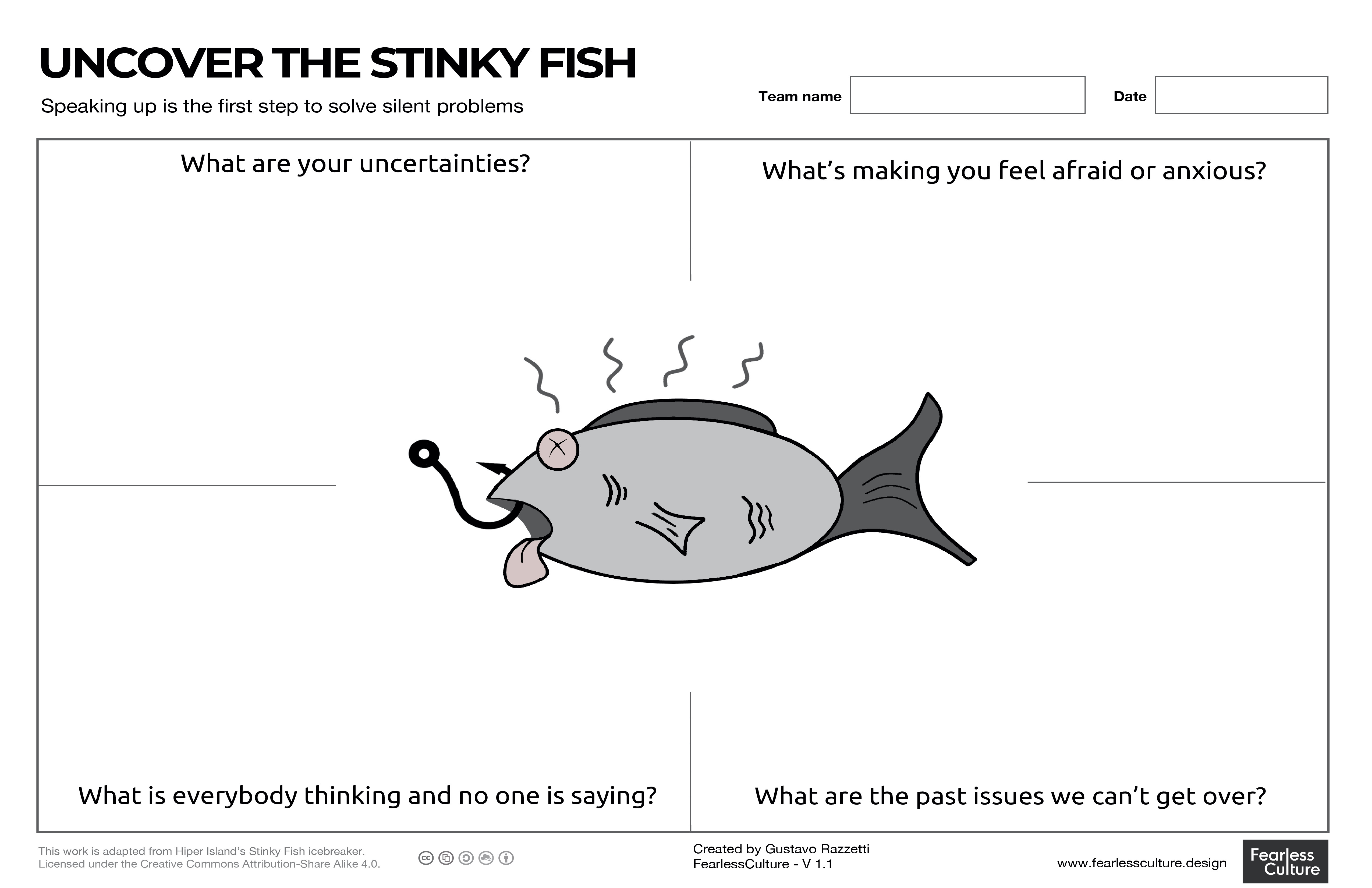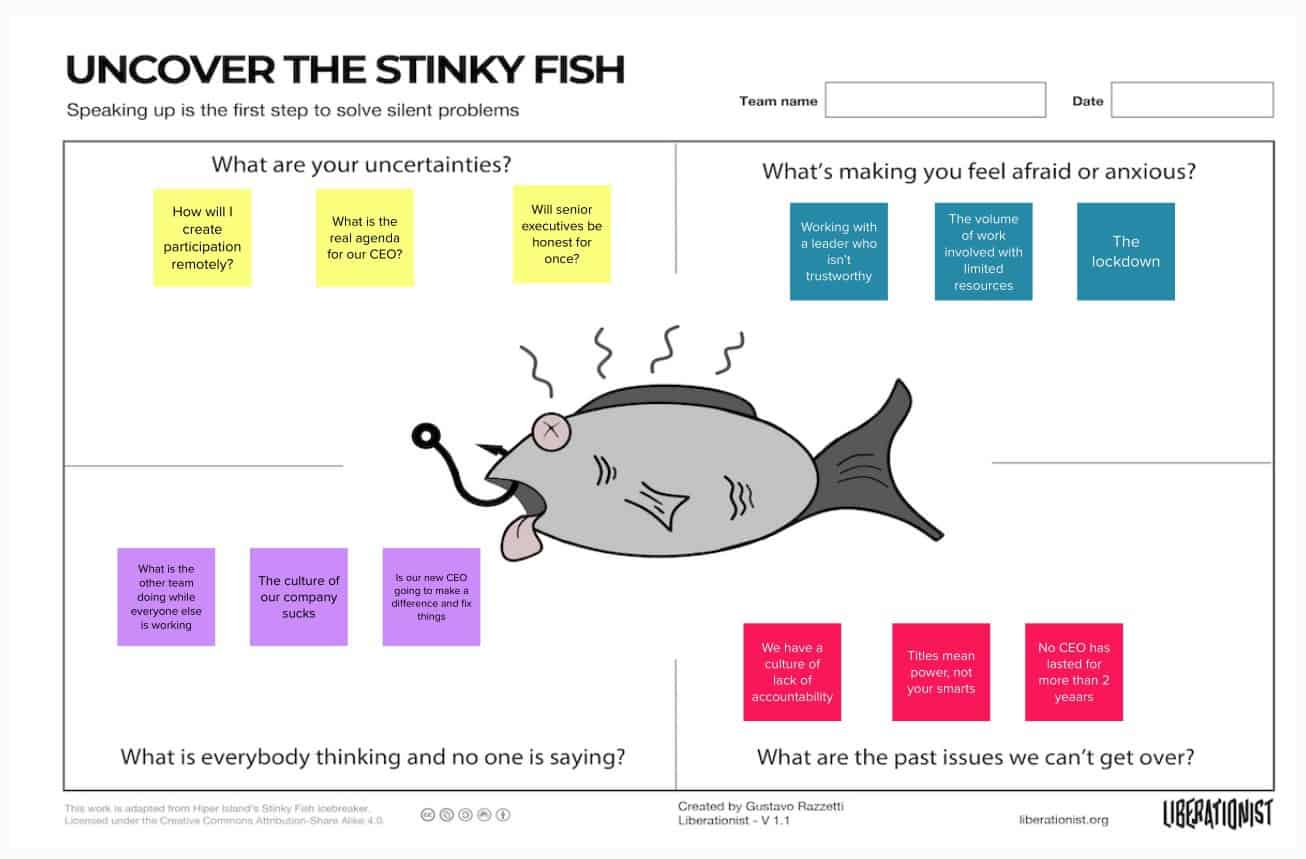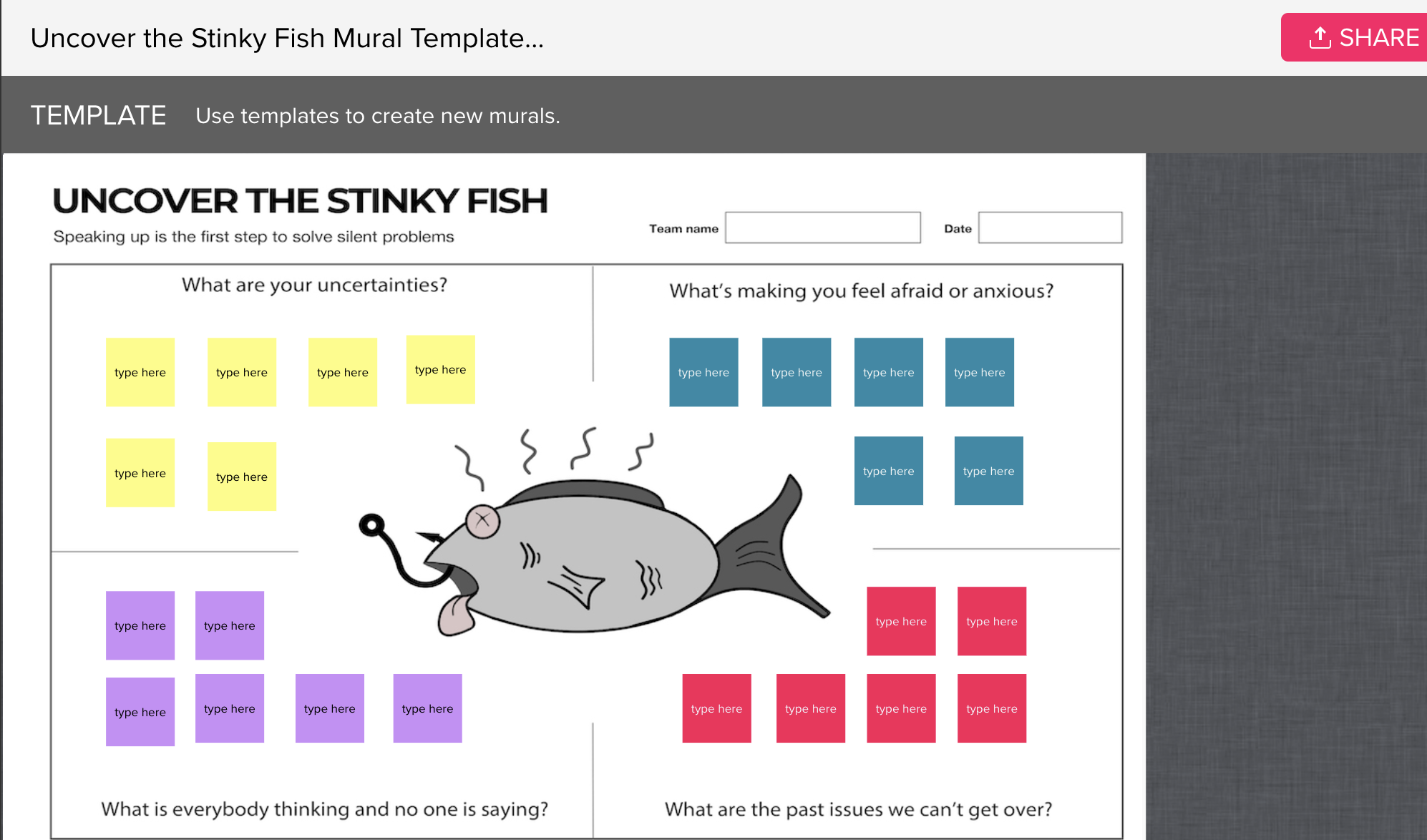
The stinky fish canvas is a metaphor for issues that we don’t want to talk about. The longer we hide things, the stinkier they get.

Get in touch and transform your culture today.
Reach out using the form below and we’ll respond as soon as possible. We appreciate your interest.

The stinky fish canvas is a metaphor for issues that we don’t want to talk about. The longer we hide things, the stinkier they get.

By Gustavo Razzetti
November 24, 2022
The Stinky Fish Canvas is a quick way to uncover silent problems. It’s a metaphor for the issues that teams carry around, but which they either don’t want or don’t care to talk about.
The problem is that the longer we hide them, the stinkier our issues get.
Turn the act of sharing your stinky fish into a regular team practice. This canvas was inspired by the namesake exercise by Hyper Island.
Share your stinky fish with the group. Compare notes. Address silent issues, fears, anxiety, and uncertainties. It’s okay to be worried or afraid about the future; it’s not okay to watch the fish rot and do nothing about it.
Identifying the stinky fish is an effective exercise for both individuals and groups to face the issues that are getting in their way of success.
The Stinky Fish Canvas helps teams identify four types of issues:
This exercise can be used to address overall team cultural tensions or during a particular transition (i.e. change of strategy, a new manager taking over the team, etc.)


Depending on the complexity or sensitivity, you might need to set the right context for this activity to be more successful.
I usually want to warm up the audience with other activities like “Who are you?” and “36 Questions to turn strangers into friends” so people start to open up.
After the individual round, I like to break the larger team into duos and let them share their stinky fish canvas with each other before a shareout with the entire group.
You can also use the 1-2-4-all approach to focus to start with individual analysis and then gradually expanding the conversation.
Wrap up the session by reminding the team about the importance of speaking up. It’s vital to build a practice of addressing issues before they become a stinky fish.

The Stinky Fish tool is a simple and effective way to uncover team tensions and align members on which to tackle first.
Proper facilitation is critical to promote candor, participation, and make people feel safe.
Here's what participants to our workshops have told us about their experience with this tool:
"The Stinky Fish is a visual way to connect all the dots."
"It helped us step back and put together what we were all thinking, but no one was saying."
"It's an objective way to gain clarity about our issues. Clarity helped us remove anxiety and focus on taking action."
"It's a relief to put it out there in the canvas."
"When you step back, you noticed that all the issues are related – most are consequences of bad decisions."
Access the Mural Stinky Fish template and create a mural per participant, and share their personal link.
I like to pre-populate the Stinky Fish with post-its to make it easier for people to fill it up. Also, I ask people to take a screenshot and send it my way. This serves two purposes. On the one hand, it forces people to complete the activity on time, and you don’t need to check Mural to see who completed or not. On the other hand, I can add the screenshots to a PowerPoint and can use it for sharing during the session, or add them to the workshop follow-up materials.

Sharing is the most critical part; people get more suspicious when they are not in the same room or can control what their managers get to see. As a facilitator, it’s vital to promote Psychological Safety and to protect people’s confidentiality.
One way I like to facilitate the virtual sharing is to ask each participant to share one post-it; it doesn’t matter from which of the four quadrants or if they decide to choose an easy topic or a hard issue.
For me, the most crucial factor is to get people talking, to get the conversation started. You can then have a second, or a third round, inviting everyone to share another post-it from their Stinky Fish. Usually, people begin to feel more comfortable and address more sensitive topics.
Another way to facilitate it, especially if you want to arrive at some common themes, is to use the 1-2-4-8-all approach. Ask people to complete their Stinky Fish on their own. Then divide participants into groups of two and assign then to Zoom breakout rooms. Give them 10-15 minutes to share each other’s Stinky Fish and discuss commonalities and differences.
Now create groups of four people each by ‘merging’ the previous duos and repeat the exercise. Run another iteration, this time with groups of eight. Lastly, bring everyone back together to the main room and allow each group to share critical findings/ themes. Consolidate all in a group Stinky Fish and then prioritize the top three issues by asking each participant to vote (each person should get three dots).
Have the team choose the top issue/ tension so that they can start brainstorming to uncover how to deal with this silent problem.
People feel more comfortable sharing their stinky fish with strangers than with their colleagues. For open workshops, this canvas can be introduced early on. For a regular team, especially one with long-standing grudges – make sure to set the room for success.
I recommend reading about building psychological safety and how to create a safe space. Without the proper setting, this exercise can quickly backfire.
The Uncover the Stinky Fish Canvas was created by Gustavo Razzetti (Copyright © 2019 by Gustavo Razzetti and licensed under the Creative Commons Attribution 4.0 International License. Design: Moira Dillon Illustration: Tristán Razzetti
Attribution — You must give appropriate credit (author name, link to the original canvas: fearlessculture.design/blog-posts/uncover-the-stinky-fish-canvas, and provide a link to the license) and indicate if changes were made. You may do so in any reasonable manner, but not in any way that suggests the licensor endorses you or your use.
Previous
Lorem ipsum dolor sit amet, consectetur adipiscing elit. Suspendisse varius enim in eros elementum tristique. Duis cursus, mi quis viverra ornare, eros dolor interdum nulla, ut commodo diam libero vitae erat. Aenean faucibus nibh et justo cursus id rutrum lorem imperdiet. Nunc ut sem vitae risus tristique posuere.
Next
Lorem ipsum dolor sit amet, consectetur adipiscing elit. Suspendisse varius enim in eros elementum tristique. Duis cursus, mi quis viverra ornare, eros dolor interdum nulla, ut commodo diam libero vitae erat. Aenean faucibus nibh et justo cursus id rutrum lorem imperdiet. Nunc ut sem vitae risus tristique posuere.